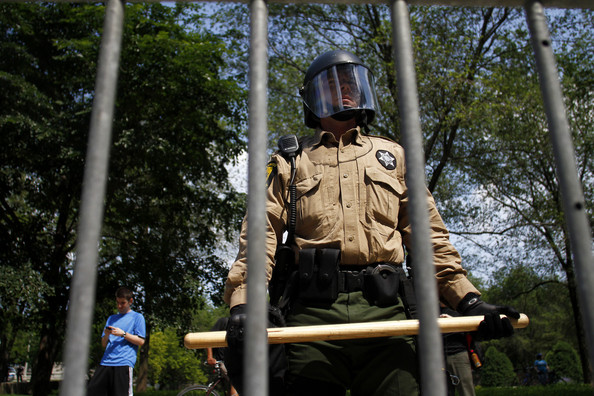Democracy relies upon dissent. Not just the theoretical possibility of protest implied by the First Amendment, but the very thing itself—flesh and blood individuals speaking truth to power and thus embodying the possibility of popular sovereignty in contexts that demonstrate both the risk and safety of political opposition. Of course, in a mass society of over 300 million people, “speaking” truth to power has less to do with words per se—although sound bytes, posters, placards, graffiti, and 140 character tweets do play a role—and more to do with visibility. Put differently, political protest is as at its root a matter of public spectacle, and its success or failure is generally a measure of who controls what is seen and by whom. Of course, governments and political operatives have known this for quite some time, and each seeks to manage the dialectic between seeing and being seen to strategic benefit. Photographers know it as well, and they too use it to strategic effects.
The NATO protests in Chicago this past weekend are an interesting case in point, as both protestors and police have jockeyed to control the public eye, each enacting what have come to be fairly conventional poses. The protestors, of course, want to be seen en masse as a way of giving a sense of solidarity and magnitude to their popular presence, but they also want to make it clear that they “see” what is going on behind the closed doors of governments and corporations. Theirs is, we might say, an attempt to embody a democratic gaze—the people seeing and being seen. Governments, on the other hand, also want to be seen, but they get caught between official political/diplomatic roles played by recognizable leaders (think of all of those photo ops you’ve seen of the heads of State shaking hands with one another, or relaxing together while watching a soccer match on the television) and the maintenance of public order, (hence lots of pictures of anonymous, paramilitary forces whose task is to “uphold the peace”). Theirs is a statist gaze or what we might call “seeing like a state.” Corporations, it seems, are generally content to remain largely invisible—their recently achieved status as individuals to the contrary notwithstanding—in a manner that implies an apolitical neutrality.
Photographers tend to capture all of this in a manner that reinforces the status quo, which is to say it underscores the sense in which our government remains democratic (dissent is allowed), even as government officials perform their tasks (leaders meet, negotiate, do their business), and the police maintain the peace (they “watch over” the scene” and “clash” with those who pose risks to public safety). Sometimes, of course, the police become over zealous and have to be reigned in (one more sign that the status quo is working) but in general they are professionals doing their job under difficult circumstances.
It is easy to be cynical of such an account, but there is a different point to be made. For such images also remind us of the importance of political spectacles as a potentially important medium of public engagement that are not entirely controlled by any one agent or set of agents, whether protestors, governments, or the media—or for that matter, the audiences that consume the images. The caption to the image above notes that the police officer shown “watches demonstrators protest” in Chicago during the first day of the NATO summit. And the point is that he wants to be seen watching—notice his stance and how he holds his baton as a visual threat to anyone who would challenge his territory or charge; indeed, the point is precisely that he needs to be seen watching in order to enact any sort of agency. But in this regard he is no different than the protestors who also need to be seen watching. Both are actors in a political spectacle.
In an important sense, democracy in particular relies on such spectacles as a way of giving presence to its effectiveness and legitimacy. And that is not an inherently bad thing, for spectacles rely upon the active involvement of a viewing audience to authenticate the experience on the ground even if its members are not directly involved in it. That said, political spectacles always come with the risk that seeing and being seen can be manipulated as absolute and hierarchical technologies of domination and control. In the photograph above, are we looking at the legitimate defender of a democratic regime or big brother? There is no final answer to that question, of course, but it is one that we need regularly and vigilantly to entertain.
Photo Credit: Joshua Lott/Getty Images North America

Discussion